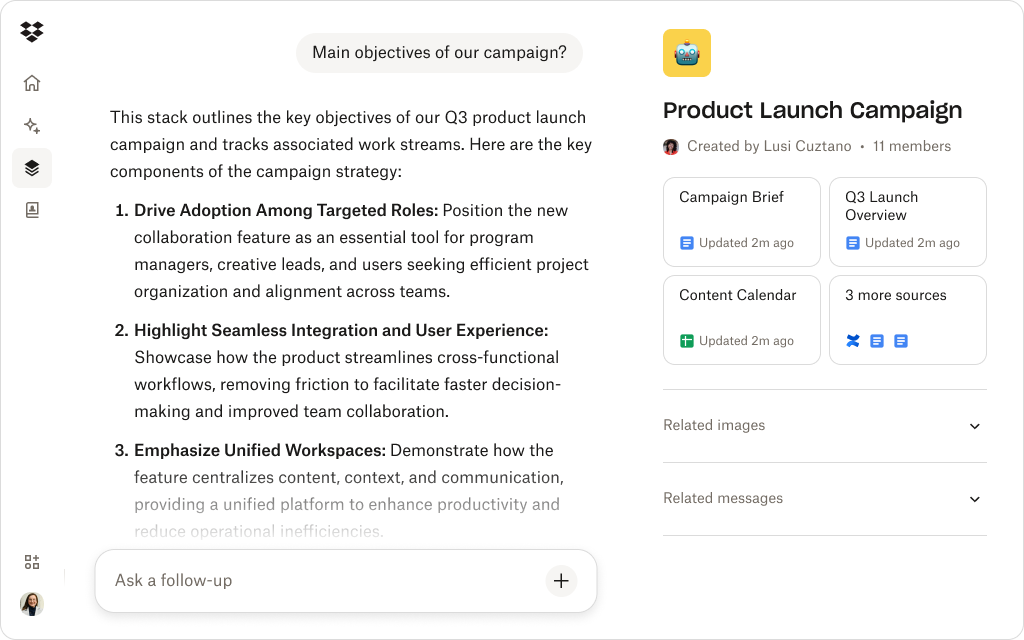
AI can help recycle ideas fast—but without guardrails, it often recycles mistakes too.
For small teams, efficiency is everything. Repurposing content—turning a webinar into a blog, a campaign into a newsletter, or a deck into social posts—feels like an easy way to scale output without starting from scratch.
AI promises to make this even faster. With just a few prompts, you can transform one long-form report into multiple short-form pieces for every channel. For marketers under pressure to produce more with less, that sounds like a dream.
But speed doesn’t always equal strategy. When AI repurposes content without understanding your intent, audience, or brand context, shortcuts can quickly become setbacks.
So how do you get the best of both worlds—the speed of AI without losing control of your brand? In this guide, we’ll explore strategies for repurposing smarter, not faster, and how tools like Dropbox Dash can help teams turn existing content into consistent, high-quality work.
Why AI content repurposing sounds so appealing
Repurposing is smart—it’s about working with what already works. A good piece of content can spark dozens of spinoffs: a quote from a blog becomes a social post, a case study becomes a sales deck.
AI takes that concept and supercharges it. Instead of manually rewriting, you can feed in existing assets and get fast, formatted outputs for every platform.
The challenge? Without brand awareness or contextual cues, AI doesn’t know what to keep—or what to leave out. It can’t tell the difference between your best-performing content and something that’s outdated or off-brand. That’s where most teams start to see cracks.

Where AI repurposing often goes wrong
AI tools are good at reformatting information—but not necessarily refining it. When they lack context, tone, or quality control, results can fall flat—or worse, create new problems.
Here’s where things often go wrong:
- Stripping nuance: AI may oversimplify ideas, removing the depth or emotion that made the original content resonate.
- Repeating old mistakes: If the source material contains outdated stats or unclear phrasing, those errors are copied—and sometimes amplified.
- Losing voice: AI models don’t inherently understand brand personality. They can drift from your brand tone or make language sound robotic or generic.
- Breaking compliance: In regulated industries, AI may unintentionally remove required disclosures or introduce non-compliant phrasing.
- Creating content gaps: AI-generated repurposing can misalign with current campaigns or messaging, leading to inconsistent customer experiences.
Research from Forrester notes that marketers using generative AI face persistent challenges in scaling content while maintaining brand voice and message consistency.
Without brand awareness or contextual cues, AI doesn’t know what to keep—or what to leave out.
The hidden costs of off-brand or low-quality reuse
At first glance, AI-generated repurposed content can look polished. But if it misrepresents your brand or fails to connect with audiences, the long-term impact outweighs the short-term gains.
Here’s what’s at stake:
- Erosion of trust: Customers notice when tone or messaging changes suddenly. Inconsistent content can make your brand feel less credible.
- SEO dilution: Repetitive or thinly rewritten content can hurt search performance, reducing visibility rather than expanding it.
- Lost efficiency: Teams spend extra time rewriting or fixing AI outputs, offsetting the time saved on the first draft.
- Compliance risk: Unchecked AI reuse can lead to inaccuracies or misstatements that put your reputation at risk.
For example, an AI-generated version of a case study might rephrase client details inaccurately—turning a success story into a potential liability. The real cost of bad repurposing isn’t the time lost—it’s the damage to brand clarity and customer confidence.

How Dash helps teams repurpose content with confidence
Dropbox Dash is built to help teams reuse ideas smartly, not recklessly. Instead of rewriting blindly, Dash surfaces past high-performing assets and connects them in context, so repurposing starts from a foundation of what’s already working.
With Dash, teams can:
- Find past winners fast—Dash universal search locates relevant campaigns, decks, or social posts instantly—even across tools like Google Drive, Slack, and Dropbox.
- Build context with Stacks—group related materials—like a campaign’s blog posts, visuals, and messaging guides—into a single Stack for easy review.
- Use Dash Chat to summarize and draft—chat can condense previous content into concise versions while referencing brand guidelines and campaign context.
- Stay on-brand—because Dash learns from approved company content, every AI-assisted draft aligns with your tone and message. You can also use admin-approved Tones and Templates in the Dash Chat Write tool.
For example, a marketing manager creating an event recap can open Dash, locate last year’s post-event summary, and prompt Chat:
“Summarize this recap for a LinkedIn post using our event tagline.”
Dash instantly generates a refined, brand-consistent draft rooted in real context—not a detached AI guess.
Make your next piece smarter, not just faster
Use Dash to turn existing content into new, high-impact assets built on real results.
Best practices for AI-assisted content reuse
AI can elevate your repurposing strategy when paired with thoughtful inputs and oversight. Here’s how to make it work:
1. Start from proven content: Feed AI with top-performing campaigns or approved assets—Dash can surface these automatically.
2. Give clear direction: Provide tone, audience, and purpose in your prompt so AI knows what success looks like.
3. Always fact-check: Verify data and links in every AI-generated draft before publishing.
4. Preserve brand elements: Use Dash Stacks to keep visual, messaging, and tone guidelines together for easy reference.
5. Review and refine: Treat AI outputs as first drafts, not finished work. Human creativity should always provide the final polish.
When guided by strong human oversight and contextual grounding, AI can repurpose content in ways that scale both creativity and consistency.
Keep every asset on brand with Dropbox Dash
AI repurposing doesn’t have to mean losing control. With Dash, teams can build from what’s already strong—past campaigns, approved messaging, and proven creative—while staying on-brand.
By connecting your AI tools to real brand context, Dropbox Dash helps your team repurpose confidently—turning every old idea into something new, polished, and perfectly on-brand.
Explore Dash today or try a demo to see how context-aware AI keeps creativity moving in the right direction.
Frequently asked questions
Because AI works best with context. Without access to your existing assets or brand tone, it risks repeating mistakes or drifting off message. Dash grounds AI in your actual work, so it starts from what already performs well.
Dash connects AI to your real content—past campaigns, brand messaging, and visuals—so every draft begins with brand context, not guesswork. That means less cleanup, more consistency, and stronger results across every channel.
Yes. Dash links decks, blogs, videos, and visuals across your tools, so your next project builds on what already works. From social snippets to long-form pieces, Dash keeps every asset aligned and reusable.

.svg)
